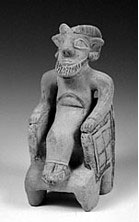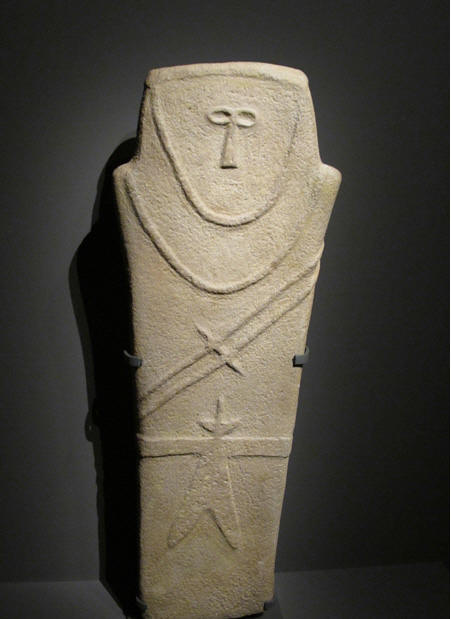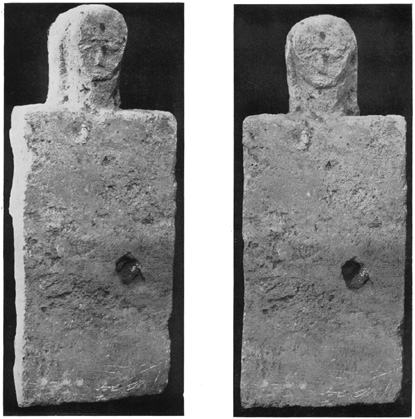


أصنام العرب قبل الاسلام
Yasin T. al-Jibouri
On p. 35 of Ibn Hisham’s Seera, the Prophet of Islam is quoted as having said that the first person to cover the creed of Ishmael son of Abraham was one Amr ibn Luhay ibn Qam`ah ibn Khindaf. This man, according to the Prophet, installed idols and started the custom of making offerings to them as well as other pagan rituals.
Amr ibn Luhay went out of Mecca to the Sham lands, today’s “Greater Syria” area which, at the time, incorporated Syria, Jordan, Lebanon and Palestine. When he came to Mab of the Balqa area, which was then inhabited by the “Amaleeq,” descendants of `Imlaq (or `Imleeq) son of Lawdh son of Sam son of Noah, and he saw them worshipping idols. He said to them, “What are these idols which I see you worshipping?” They told him that they were worshipping them because whenever they pleaded to them to let the rain fall, they responded, and whenever they sought victory over their foes, they obliged. Amr said to them, “Could you please give me an idol so I may take it to the land of the Arabs to worship it?”
They gave him an idol called Hubal, a huge idol in the shape of a man.

It was given to Amr by the Moabites of Syria, and it became Mecca's chief idol. Amr brought it to Mecca, installed it and ordered people to worship and glorify it. It was placed near a well (perhaps Zamzam) in the depth of the Ka`ba precincts. This was the idol worshipped by Quraish.
It is said that the first stone worship was started among the descendants of Ishmael. Whenever a man left Mecca from among them, or whenever someone wanted to migrate due to harsh living conditions, he would carry one of the stones of the Haram, the Ka`ba, as a sign of glorifying it. Whenever someone reached his destination, he would put it down and circle it as pilgrims used to circle the Ka`ba during those days. Gradually, they started worshipping whatever stones they deemed to be good and which they liked, forgetting their original pristine faith, changing the religion of Abraham and Ishamel for this idol worship, thus joining other misled nations. But there were few among them who safeguarded their creed. They glorified the Ka`ba, circled it, performed the hajj and `umra, stood on `Arafa and Muzdalifa, offered sacrifices and introduced beliefs of their own in all of these “rituals”.
Idol worship goes back to the time of Prophet Noah whose folks worshipped idols about which we are told in the Holy Qur’an:
وَقَالُوا لا تَذَرُنَّ آلِھَتَكُمْ وَلا تَذَرُنَّ وَدًّا وَلا سُوَاعًا وَلا يَغُوثَ وَيَعُوقَ وَنَسْرًا، وَقَدْ
أَضَلُّوا كَثِيرًا وَلا تَزِ دِ الظَّالِمِينَ إِلاَّ ضَلالا
“And they have said (to each other), `Do not abandon your gods; abandon neither Wudd nor Suwa`, neither Yag
ūth nor Ya`ūq, nor Nasr.' They have already misled many, and (O Lord!) grant no increase to the wrongdoers except in straying (from the right path).”
(Qur’an, 71:23-24)
Those from among the offspring of Ishamel and others who worshipped these idols, calling them by their names when they abandoned Ishamel’s creed, were the tribes of Hudhayl ibn Mudrikah ibn Ilyas ibn Mudar who worshipped Suwa`, while the tribe of Kalb ibn Wabrah, of Quda`h worshipped Wudd in the Domat al-Jandal, a town that now lies in the northern part of Saudi Arabia, that is, in the Hijaz area. An`um, a branch of the ±ay tribe, and the people of Jericho who belonged to the Madhhaj tribe, opted to worship Yaghuth. Those who worshipped Yaghuth were Khaywan people who descended from Hamdan and who resided mostly in Yemen.

Dhu al-Kula`, offspring of the populous Himyar tribe, worshipped Nasr in the Himyar areas. In addition to these ancient idols that were brought back to life after Noah’s flood, there were many other tribes that were worshipped throughout the Arabian Peninsula: `Umyanis, a branch of the Khawlan tribe, was the name of an idol which was worshipped in the land of Khawlan. Khawlan was Amr ibn Ilhaf ibn Quza`ah. Some descendants of Quza`h embraced Judaism and migrated from the land of Khawlan in Yemen to Yathrib, Medeena. Khawlan remains to be a populated area of Yemen that has its own tribal chiefs who now are all Muslims.

Tribesmen belonging to Banu Milkan ibn Kinanah ibn Khuzaymah ibn Mudrikah ibn Ilyas ibn Mu
dar used to have an idol called Sa`d, a tall stone in a plain in their land. A man from Banu Milkan brought his camels to this idol seeking its “blessing.” The idol was stained with the blood of the animal offerings. Seeing it thus covered with blood, the camels were frightened, and they aimlessly ran away in all direction. Their poor Milkani owner became very angry, took a stone and threw it at Sa`d then sought to get his camels back. Once he had them gathered in his possession, he composed these two lines of poetry:

We came to Sa`d so he may unite us together, But Sa`d disunited us, so we have nothing to do with Sa`d. Is Sa`d anything but a stone in a plain of land That calls for neither misguidance nor guidance?
There were two other idols near the location of the Zamzam well: Isaf and Na’ila in the same of a man and a woman respectively. Both Isaf and Na’ila had belonged to the Jurham tribe (in which Prophet Ishmael had married), and the full name of the first was Isaf ibn Baghi and that of the woman was Na’ila daughter of Deek. Isaf had a sexual intercourse with Na’ila inside the holy precincts of the Ka`ba, so both were turned into stones, they said, and surely Allah knows best.
How did the Arabs worship those stone idols?
Each house had an idol which the residents worshipped. When a man was going out on a trip, he would rub his hands on it which was the last thing he did before starting his trip. He would do the same as soon as he returned home to his family. In addition to the Ka`ba, the Arabs had other places of worship which they called
tawagheet طواغيت , and they held them in esteem as they did to the Ka`ba. These places of worship had their own clergy and caretakers, and offerings to them were made. People would circle them the same way they used to circle the Ka`ba while knowing that the latter was superior to them all due to being the edifice erected by Abraham, the Friend of Allah, and his mosque.
Quraish tribe had another idol which it worshipped with the Banu Kinanah tribes men at the Nakhla area, and its/her name was `Uzza which it had its own clergy and caretakers from among the Banu Shayban of Sulaym, allies of Banu Hashim, particularly of the offspring of Abu Talib.
There was another goddess idol which the residents of Thaqeef in Ta’if worshipped and which was taken care of by Banu Mu`attib of Thaqeef, and this was the Lat.
The Aws and the Khazraj, as well as some other residents of Yathrib, worshipped another idol goddess named Manat on the sea shore of the Red Sea from the Mushallal area of Qudaid, about 150 km distance north of Mecca.
“Dhul-Khalasah” was an idol worshipped by Daws, Khath`am and Bajeela tribes and some other people in the Tabala area, 48 km south of Mecca.
The populous Tay tribe and those who resided beyond both mountains in its domiciled area, namely Salma and Aja’ mountains, worshipped Fils idol. Their place of worship, we are told on pp. 38–39 of Ibn Hisham’s
Seera, was demolished by Imam Ali ibn Abu Talib who found two swords there one of which was called ar-Rasoob and al-Mikhdham and which Ali brought to the Prophet who gave them both to him.
Himyar and the Sana people of Yemen worshipped an idol called Ri’am.
According to Ibn Ishaq, as Ibn Hisham tells us, there was an idol house of worship built by Banu Rabee`ah ibn Ka`b ibn Sa`d iby Yazid ibn Manat ibn Tamim called Ruda’.
Finally, another major idol worshipped by some of pre-Islamic Arabia folks was called “Dhul-Ka`bat ذو الكعبات ” which was worshipped by Bakr, Taghlib, descendants of Wa’il, and Iyad in the Sandad area which is not far from Riyadh.
These are the main idols worshipped by many Arabs during the jahiliyya period which preceded that of Islam, and surely Allah knows best.